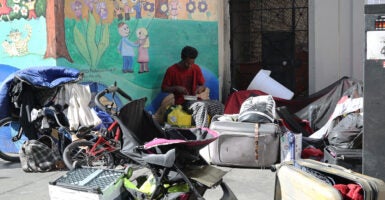When I graduated from Princeton in 1981, there were two things that I wanted to do: make my living as a writer and live in the city where I was born.
That was San Francisco.
During some summers in my college years, I had worked for a family-owned car rental company that had its headquarters on O’Farrell Street in San Francisco’s Tenderloin district.
I also worked there in my first two years out of college.
During that time, I commuted to the Tenderloin from the Marin County seat of San Rafael, where I lived with my parents in the home where I grew up.
While San Rafael and the Tenderloin were within commuting distance of one another, they were about as culturally distinct as two places in the Bay Area could be.
San Rafael was a model for the American suburb. Its tree-lined residential streets were flanked by beautiful old Victorian and Tudor-style houses. Its main street—occupied by small, family-owned businesses—was so iconic it became a featured location in “American Graffiti,” the movie about high school kids that launched the legendary film career of George Lucas.
The Tenderloin, by contrast, had no trees. But it did have a number of disheveled men, some of whom appeared to be engaged in disreputable enterprises.
It was indisputably one of San Francisco’s roughest neighborhoods.
But in the late 1970s and early 1980s, homeless encampments did not actually block the sidewalks there. That is not the case today.
The Daily Mail published a story this week that was featured on the Drudge Report. It was headlined: “San Francisco worker posts terrifying walk past drug-addled homeless people passed out on the sidewalk in the city’s Tenderloin district.”
“TikToker ‘Freqmeek’ captured the pre-dawn horror as she gingerly picked her way through dozens of desperate addicts in the Tenderloin district,” the Daily Mail reported.
“There are so many concerns and protections in place for the drug users and homeless people but what about the working class that have to pray that they make it to and from work in this environment,” the Daily Mail quoted the TikToker as saying.
The report included a photograph of people camping on a sidewalk.
British Home Secretary Suella Braverman, as noted by the Daily Mail, sent out messages on X (formerly Twitter) that cited San Francisco and Los Angeles as examples of why she wants to stop people from sleeping in tents on the streets of Great Britain.
“Nobody in Britain should be living in a tent on our streets,” said Braverman.
“Unless we step in to stop this,” she said, “British cities will go the way of places in the U.S. like San Francisco and Los Angeles, where weak policies have led to an explosion of crime, drug taking, and squalor.”
What has happened to San Francisco since the 1980s? Has it dropped into poverty?
Quite the contrary: It has become a wealthier city.
According to Census Bureau data posted online by the Federal Reserve Bank of St. Louis, San Francisco in 1989 had a median household income of $30,166 (which equals $74,278 in September 2023 dollars, according to the Bureau of Labor Statistics inflation calculator). In 2021, according to this data posted by the Federal Reserve, it was $119,776.
Yet, homelessness has risen in San Francisco even as the median household income has climbed. According to biannual surveys conducted by the city at the direction of the federal Department of Housing and Urban Development, there were 5,404 homeless people in San Francisco in 2005. By 2013, that had climbed to 7,008. In 2019, it hit 8,035. Then, in 2022, it dropped slightly to 7,754.
How does one of the wealthiest counties in the United States have a neighborhood where people sleep on the sidewalks?
The people who run the city and those who are responsible for enforcing the laws there have allowed it to happen.
Homeless people should be put in shelters, mentally ill people should be properly cared for, and criminals should be fairly prosecuted and punished for their crimes.
A city and a state that leave the homeless, the helpless, and criminals on the street is not helping them or the innocent citizens who must deal with them on their own.
COPYRIGHT 2023 CREATORS.COM
The Daily Signal publishes a variety of perspectives. Nothing written here is to be construed as representing the views of The Heritage Foundation.
Have an opinion about this article? To sound off, please email [email protected] and we’ll consider publishing your edited remarks in our regular “We Hear You” feature. Remember to include the URL or headline of the article plus your name and town and/or state.































